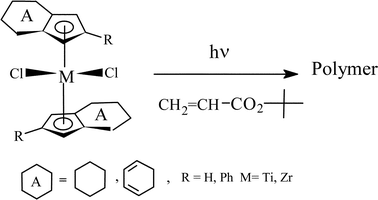From zirconium to titanium: the effect of the metal in t-butylacrylate photoinitiated polymerisation
Abstract
We report here the synthesis, photochemistry and photoinitiator activity of some

* Corresponding authors
a
C.N.R., Istituto per la Sintesi Organica e la Fotoreattività (I.S.O.F.), sez. Ferrara, via L. Borsari 46, Ferrara, Italy
E-mail:
tr3@dns.unife.it
Fax: +39 0532 24 0709
Tel: +39 0532 29 1159
b
Dipartimento di Chimica dell'Università di Ferrara, via L. Borsari 46, Ferrara, Italy
E-mail:
tr2@dns.unife.it
Fax: +39 0532 24 0709
Tel: +39 0532 29 1158
We report here the synthesis, photochemistry and photoinitiator activity of some

 Please wait while we load your content...
Something went wrong. Try again?
Please wait while we load your content...
Something went wrong. Try again?
E. Polo, A. Barbieri and O. Traverso, New J. Chem., 2004, 28, 652 DOI: 10.1039/B315482C
To request permission to reproduce material from this article, please go to the Copyright Clearance Center request page.
If you are an author contributing to an RSC publication, you do not need to request permission provided correct acknowledgement is given.
If you are the author of this article, you do not need to request permission to reproduce figures and diagrams provided correct acknowledgement is given. If you want to reproduce the whole article in a third-party publication (excluding your thesis/dissertation for which permission is not required) please go to the Copyright Clearance Center request page.
Read more about how to correctly acknowledge RSC content.
 Fetching data from CrossRef.
Fetching data from CrossRef.
This may take some time to load.
Loading related content
